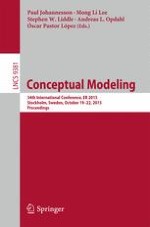This book constitutes the refereed proceedings of the 34th International Conference on Conceptual Modeling, ER 2015, held in Stockholm, Sweden, in October 2015. The 26 full and 19 short papers presented were carefully reviewed and selected from 131 submissions. The papers are organized in topical sections on business process and goal models, ontology-based models and ontology patterns, constraints, normalization, interoperability and integration, collaborative modeling, variability and uncertainty modeling, modeling and visualization of user generated content, schema discovery and evolution, process and text mining, domain-based modeling, data models and semantics, and applications of conceptual modeling.
